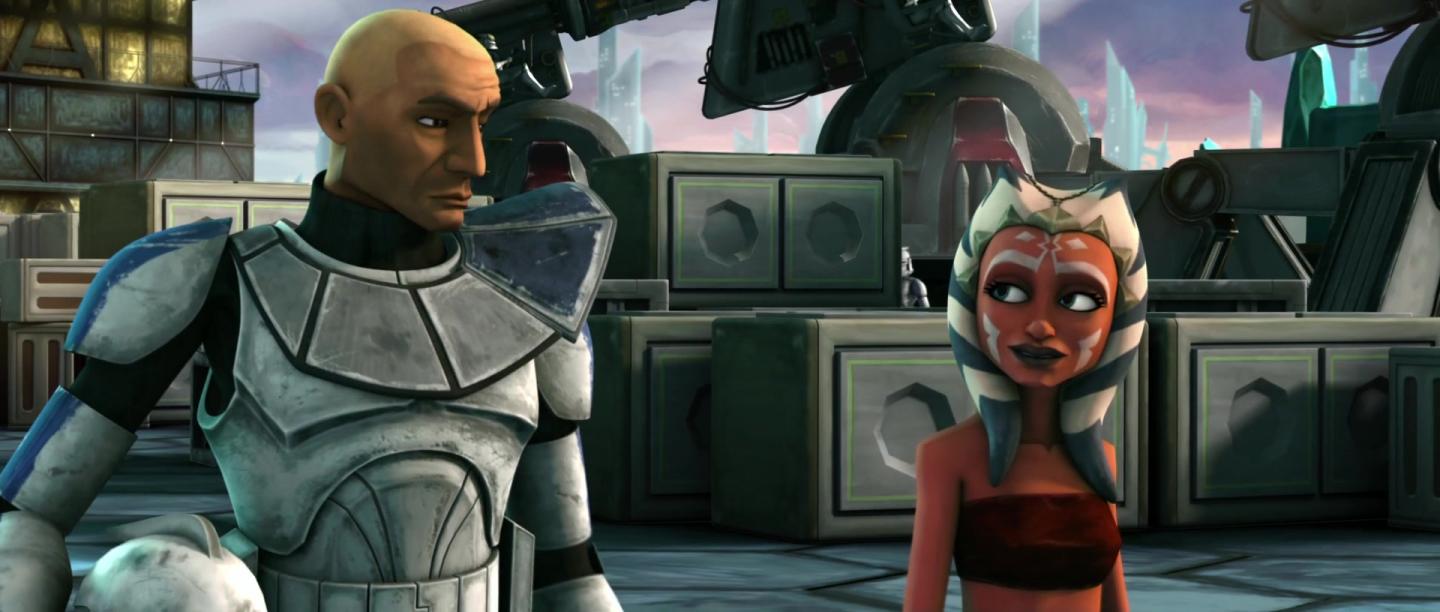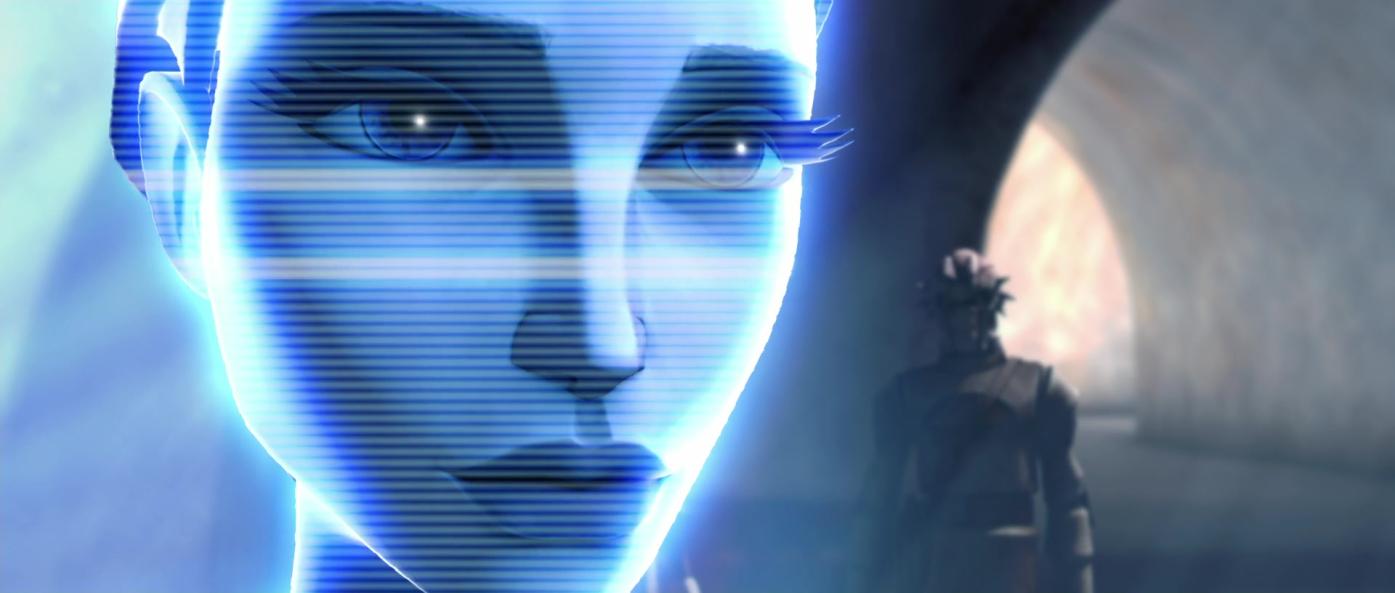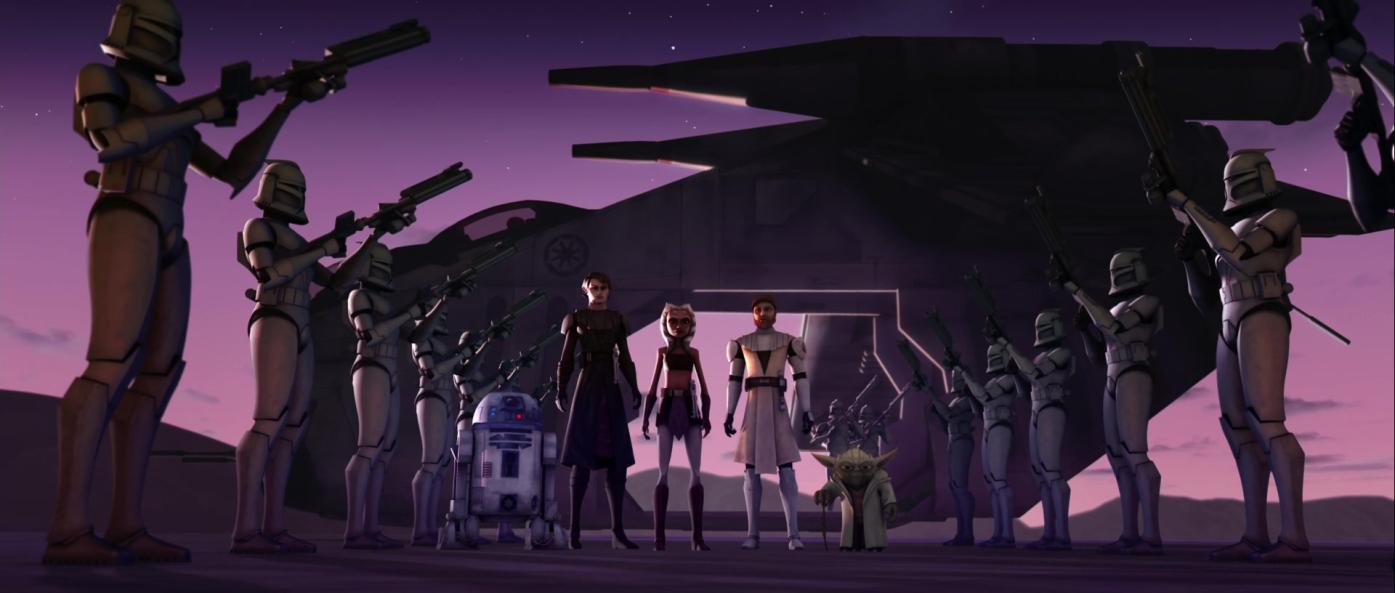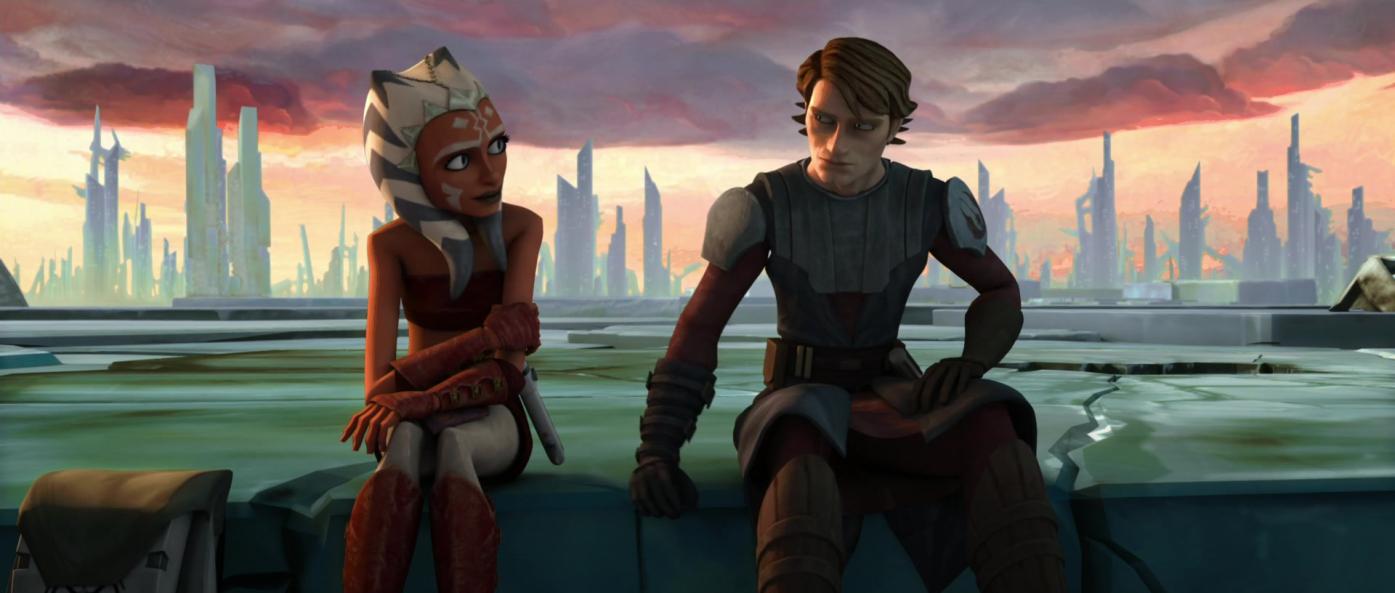Last time, I talked about Star Wars: The Clone Wars 2003. This week, it’s 2008’s turn. I start with the movie debut of the animated series, if only because it introduces Ahsoka Tano.
I remember the first time I’ve seen every Star Wars film. The first of firsts, of course, was my parents’ VHS copy of the Original Trilogy–I was very intimidated by Luke’s abs from the original cover art. I remember begging my parents to see Phantom Menace in the fancy theater because we could only afford the dollar seats on the rare occasion we treated ourselves. My brother and I pooled gift money to take our parents out to Attack of the Clones, though we told them we were treating them to dinner so we could surprise them. There was only enough money for tickets, so our “dinner” was homemade peanut butter sandwiches eaten in the cafeteria while we waited for the movie to start. I was profoundly moved by Anakin’s tragedy in Revenge of the Sith when I saw it in theaters.
The Clone Wars is no exception. At the time, I didn’t know Clone Wars was a precursor to the animated series, but I knew it was Star Wars, and it reminded me of comfort and safety during a time where I felt neither comfortable nor safe.
To someone who had not grown up with Leia wielding a lightsaber, Ahsoka Tano was a gift. Sure there was Mara Jade, but she wasn’t on-screen. (I later learned there were even more Force wielding women in the Legends universe, but I never dived deeply into that because I made the mistake of reading Splinter in the Mind’s Eye, which made me deeply skeptical of the Star Wars novels as a whole for a very long time.)
Essentially, my emotional attachment to The Clone Wars movie is not rooted in any inherent “goodness” of the actual film. Objectively speaking, it’s quite terrible.
The fight scenes are too long. The banter between Ahsoka and Anakin is forced more than half the time. Even Ventress, introduced as Dooku’s assassin, is just there being evil and flirting with malevolent intent at Obi-Wan Kenobi. Padmé isn’t even introduced until more than halfway through the film. For some reason, they couldn’t bother giving Ahsoka traditional Jedi garb and they put her in that horrible shirt.
The most unforgivable facet of Clone Wars, though, is its plot. Essentially, thanks to the terrible Separatists, the Republic is cut off from their clone army and various supplies. Jabba the Hutt, a firmly established villain and slaver in previous films, controls space lanes that will aid the Republic in accessing said army and supplies. When Jabba’s son is kidnapped, the Republic jumps at the chance to find themselves in Jabba’s good graces.
Mace Windu puts up a small resistance, but due to Chancellor Palpatine’s manipulations, the plot moves forward. Ahsoka is dispatched to meet up with Obi-Wan and Anakin in order to let them know their new mission while they are entrenched in a battle for the planet of Christophsis. This battle allows the viewer to see Anakin and Ahsoka in action before the real plot begins. It’s revealed the kidnapping was arranged by the Separatists all along to cast aspersion on the Jedi Order because that’s what Palpatine aka Darth Sidious does during this elaborate chess game known as the Clone Wars wherein Palpatine is primarily playing against himself. In the end, though, the Jedi return Jabba’s son, Jabba understands this was the Separatists’ fault the whole time, and the Republic have themselves a minor little victory.
I love every terrible minute of it, and here’s why.
Reason Number One: Ahsoka Tano and Anakin Skywalker

Ahsoka Tano is initially introduced as a padawan learner that Obi-Wan mistakes for his new apprentice, until she reveals she’s been assigned to Anakin Skywalker. Everyone is shocked. Anakin doesn’t want a padawan. Later, Yoda reveals that Ahsoka was assigned to Anakin so that he can learn to let go.
Let’s take a moment of silence to observe how well that plan turned out for all of them.
But though their personalities clash–Ahsoka is new to the front lines and a child–she possesses a type of recklessness that meshes well with Anakin’s particular brand of recklessness in a way that brings balance to each other.
When Ahsoka says her part is to be an enthusiastic supporter of Anakin’s battle strategies, Anakin comes up with a brilliant plan to get behind enemy lines. When Anakin has no plan to move forward after rescuing Jabba’s son, Ahsoka comes up with a viable solution. As they scale cliffs, Anakin instructs Ahsoka to stay close to him as droids barrage them with laser fire. He thinks she hasn’t done that until she comes in with a swooping save and says, “I can’t get much closer, Skyguy.” Later, towards the end of the film, Anakin says they must split up in order to save Jabba’s son even as Ahsoka protests, “We’ll face it together, Master.” She doesn’t understand how there can be a more important mission than keeping Anakin alive, to which Anakin exhorts her to trust him.
For those who know what’s coming, these scenes are an agonizing kind of foreshadowing. Technically, I suppose, the film gets better the deeper into the animated series you go. These moments age well.
Anakin’s and Ahsoka’s best moments, though, are in the middle of the film, just before they set off to rescue Jabba’s son.
Anakin sits beside a despondent Ahsoka. Sure they won the day, but she knows Anakin didn’t want her as his padawan, and their personality clashes still sting. Yet Anakin says, “You’re reckless, little one. You never would have made it as Obi-Wan’s padawan. But you might make it as mine.”
The joy that replaces her grief is tangible on her face.
Anakin’s acceptance of her, his validation of her, is something that’s not often seen for young girls, and it really sets the stage for Ahsoka’s story.
Reason Number Two: Captain Rex & The Clones

As I watched this again in preparation for writing this article, the casual deaths of each trooper stung me, especially when they made me laugh.
There’s a scene early in the film. A trooper charges a droid and punches it in the face. Maybe the blaster was out of ammo. Maybe it was adrenaline and fear and anger. Who knows why he did it, but he did.
But the trooper rears back, screaming. His hand is face level. He hit a metal clanker with his fist, and it hurt.
It’s funny because it’s unexpected. It’s so human. How many times have we hurt our hands doing something stupid?
Halfway through his arrgh!, the droid shoots him, and he collapses, very dead. Beat of humor captured, the film moves on, and I’m left reeling in my emotions.
Over and over, the clones are shown being mowed down by blaster fire. They die, and they die, and they die again.
The viewer doesn’t know these clones yet–but they will in the series. This is another example where watching this film after the series will hit different emotional beats.
Ultimately, Captain Rex becomes one of the most well known and beloved clones. I love the scene where Rex and Ahsoka have their first conversation with each other, where he tells her that experience outranks everything, and her answer is to tell him then she should go get some. It sets the stage for how their relationship will develop throughout the series.
In the film, Rex’s moment to shine is when Ventress attempts to coerce him to call Anakin and reveal his location to her via a mind trick.
But Rex resists. Instead of calling Anakin, “General Skywalker,” he speaks to him by name, which clues the Jedi into the fact Rex has been captured. Rex ends up not betraying his companions in arms that day.
Anakin feels great loyalty to the clones, but specifically to Rex. In typical Anakin fashion, he’s willing to throw it all away in order to rescue Rex when he and his men are pinned down by battle droids. Ahsoka pulls him back to their objective: delivering Jabba’s son. When Anakin tells Rex he needs to leave him behind, Rex says, “The mission always comes first, sir.”
The film clearly defines the mission (rescue the Huttlet), but it fails to interrogate what the mission means.
Is it to align with someone as terrible as Jabba the Hutt in order to win a war? The movie actually goes out of its way to minimize just how terrible Jabba is. Anakin’s past as a slave, sold by a Hutt, is looked at sideways, without naming it. The Twi’lek dancer performs in front of Jabba without chains. The clones themselves cannot even be named for what they are–fodder for the machine of war, created for it without choice, and purchased from the Kaminoans–slaves of the Republic.
Yes, the show is targeted to a younger viewing audience, yet Clone Wars shies away from these deeper, more uncomfortable themes when it should not. This is a pattern that will be continued in the animated series.
Reason Number Three: Padmé Amidala

Padmé doesn’t get a lot of time to shine in this. Like I said earlier, she is introduced near the end of the film. She’s the one who discovered the plot against Jabba originated from his uncle, Ziro the Hutt, who partnered with Count Dooku to make it happen. The Separatists keep the space lanes, and Ziro takes Jabba’s place. Everyone walks away a winner except for the Jedi and the Republic.
Even though Padmé has badass moments where she’s defeating droids with blasters and physical combat, where she outsmarts them so she can alert Threepio for aid, my favorite Padmé moment isn’t about that.
It’s about the tender moment shared between Anakin and Padmé at the end of the movie after Padmé has negotiated a cessation of hostilities. They cannot be their true selves because they are surrounded by too many witnesses. “Senator, you have my undying gratitude,” Anakin says.
“No, Master Skywalker. It is I, and the Republic, who owes you thanks.”
The careful use of their titles, the way their eyes meet and soften, indicate an unspoken yet ultimate tender I love you // I know moment.
Reason Number Four: Foreshadowing
Though Darth Vader’s musical theme does not make an appearance in this, I did appreciate how much of the original trilogy is foreshadowed in it.
When Anakin and Ahsoka escape with Jabba’s son, Dooku has to scramble to edit the elaborate ruse he’s created to deceive Jabba. He warns Jabba that after kidnapping and killing the Huttlet, Skywalker is now on his way to slay Jabba himself.
Yet Anakin is not the Skywalker who ultimately returns to Tatooine to kill Jabba.
It’s his daughter, Leia, in Return of the Jedi.
In Conclusion

If nothing else, watch it for Artoo complaining bitterly about the sand on Tatooine, an echo of Threepio in A New Hope.
It establishes thematic elements that will occur over and over: Ahsoka and Anakin as a dynamic duo and what they mean to each other, Padmé’s and Anakin’s forbidden romance, the clones and their struggles, and the terrifying, looming shadow of the dark side, specifically in how it uses and abuses its victims. I still receive shivers when Dooku advises Ventress that he will discuss her failure at a later time
It would be far too tedious and mundane to offer write ups for each individual episode. Moving forward, I will be writing about Essential Episodes for various characters and themes. First up, will be a series of articles regarding the Essential Episodes for Ahsoka Tano.
You can stream Star Wars: The Clone Wars on Disney+.